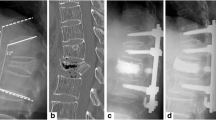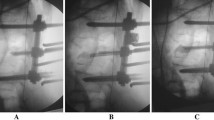Abstract
The number of reports describing osteoporotic vertebral fracture has increased as the number of elderly people has grown. Anterior decompression and fusion alone for the treatment of vertebral collapse is not easy for patients with comorbid medical problems and severe bone fragility. The purpose of the present study was to evaluate the efficacy of one-stage posterior instrumentation surgery for the treatment of osteoporotic vertebral collapse with neurological deficits. A consecutive series of 21 patients who sustained osteoporotic vertebral collapse with neurological deficits were managed with posterior decompression and short-segmental pedicle screw instrumentation augmented with ultra-high molecular weight polyethylene (UHMWP) cables with or without vertebroplasty using calcium phosphate cement. The mean follow-up was 42 months. All patients showed neurologic recovery. Segmental kyphotic angle at the instrumented level was significantly improved from an average preoperative kyphosis of 22.8–14.7 at a final follow-up. Spinal canal occupation was significantly reduced from an average before surgery of 40.4–19.1% at the final follow-up. Two patients experienced loosening of pedicle screws and three patients developed subsequent vertebral compression fractures within adjacent segments. However, these patients were effectively treated in a conservative fashion without any additional surgery. Our results indicated that one-stage posterior instrumentation surgery augmented with UHMWP cables could provide significant neurological improvement in the treatment of osteoporotic vertebral collapse.




Similar content being viewed by others
References
Ataka H, Tanno T, Yamazaki M (2009) Posterior instrumented fusion without neural decompression for incomplete neurological deficits following vertebral collapse in the osteoporotic thoracolumbar spine. Eur Spine J 18:69–76
Chang KW, Chen YY, Lin CC et al (2005) Closing wedge osteotomy versus opening wedge osteotomy in ankylosing spondylitis with thoracolumbar kyphotic deformity. Spine 30:1584–1593
Cheh G, Bridwell KH, Lenke LG et al (2007) Adjacent segment disease following lumbar/thoracolumbar fusion with pedicle screw instrumentation: a minimum 5-year follow-up. Spine 32:2253–2257
Fujiwara A, Kobayashi N, Saiki K et al (2003) Association of the Japanese Orthopaedic Association score with the Oswestry disability index, Roland–Morris disability questionnaire, and short-form 36. Spine 28:1601–1607
Ito M, Kaneda K (2004) Osteopenia: vertebrectomy and fusion. In: Herkowitz H, Dvorak J, Bell G, Nordin M, Grob D (eds) The lumbar spine, 3 edn. Lippincott Williams & Wilkins, pp 683–689
Japanese Orthopaedic Association (1976) Criteria on the evaluation of treatment of cervical myelopathy. J Jpn Orthop Assoc 49:addenda no. 5
Kaneda K, Asano S, Hashimoto T (1992) The treatment of osteoporotic-posttraumatic vertebral collapse using the Kaneda device and a bioactive ceramic vertebral prosthesis. Spine 17 S:295–303
Kaneda K, Taneichi H, Abumi K et al (1997) Anterior decompression and stabilization with the Kaneda device for thoracolumbar burst fractures associated with neurological deficits. J Bone Joint Surg Am 79:69–83
Kim KT, Suk KS, Kim JM et al (2003) Delayed vertebral collapse with neurological deficits secondary to osteoporosis. Int Orthop 27:65–69
Korovessis P, Hadjipavlou A, Repantis T (2008) Minimal invasive short posterior instrumentation plus balloon kyphoplasty with calcium phosphate for burst and severe compression lumbar fractures. Spine 33:658–667
Matsuyama Y, Goto M, Yoshihara H et al (2004) Vertebral reconstruction with biodegradable calcium phosphate cement in the treatment of osteoporotic vertebral compression fracture using instrumentation. J Spinal Disord Tech 17:291–296
Mermelstein LE, McLain RF, Yerby SA (1998) Reinforcement of thoracolumbar burst fractures with calcium phosphate cement. A biomechanical study. Spine 23:664–670
Murakami H, Yamazaki K, Attallah-Wasif ES et al (2006) A biomechanical study of 3 different types of sublaminar wire used for constructs in the thoracic spine. J Spinal Disord Tech 19:442–446
Saita K, Hoshino Y, Higashi T et al (2008) Posterior spinal shortening for paraparesis following vertebral collapse due to osteoporosis. Spinal Cord 46:16–20
Shikata J, Yamamuro T, Iida H et al (1990) Surgical treatment for paraplegia resulting from vertebral fractures in senile osteoporosis. Spine 15:485–489
Soshi S, Shiba R, Kondo H et al (1991) An experimental study on transpedicular screw fixation in relation to osteoporosis of the lumbar spine. Spine 16:1335–1341
Suk SI, Kim JH, Lee SM et al (2003) Anterior–posterior surgery versus posterior closing wedge osteotomy in posttraumatic kyphosis with neurologic compromised osteoporotic fracture. Spine 28:2170–2175
Takahata M, Ito M, Abumi K et al (2007) Comparison of novel ultra-high molecular weight polyethylene tape versus conventional metal wire for sublaminar segmental fixation in the treatment of adolescent idiopathic scoliosis. J Spinal Disord Tech 20:449–455
Uchida K, Kobayashi S, Nakajima H et al (2006) Anterior expandable strut cage replacement for osteoporotic thoracolumbar vertebral collapse. J Neurosurg Spine 4:454–462
Verlaan JJ, Dhert WJ, Verbout AJ et al (2005) Balloon vertebroplasty in combination with pedicle screw instrumentation: a novel technique to treat thoracic and lumbar burst fractures. Spine 30:E73–E79
Wang XY, Dai LY, Xu HZ et al (2008) Kyphosis recurrence after posterior short-segment fixation in thoracolumbar burst fractures. J Neurosurg Spine 8:246–254
Author information
Authors and Affiliations
Corresponding author
Rights and permissions
About this article
Cite this article
Sudo, H., Ito, M., Abumi, K. et al. One-stage posterior instrumentation surgery for the treatment of osteoporotic vertebral collapse with neurological deficits. Eur Spine J 19, 907–915 (2010). https://doi.org/10.1007/s00586-010-1318-9
Received:
Revised:
Accepted:
Published:
Issue Date:
DOI: https://doi.org/10.1007/s00586-010-1318-9




